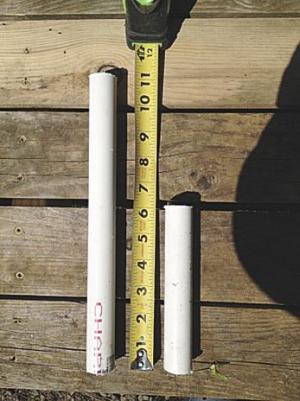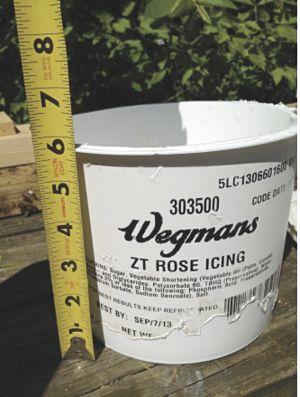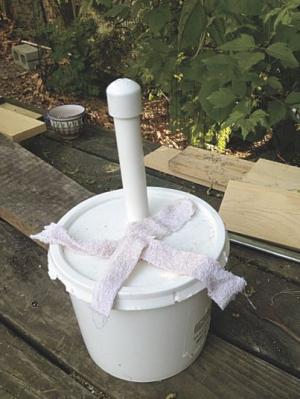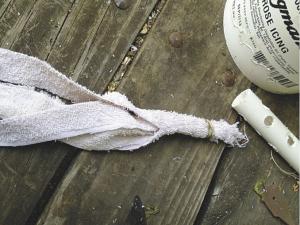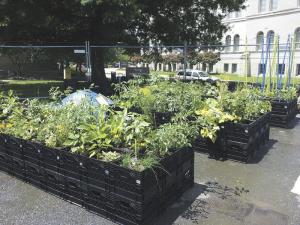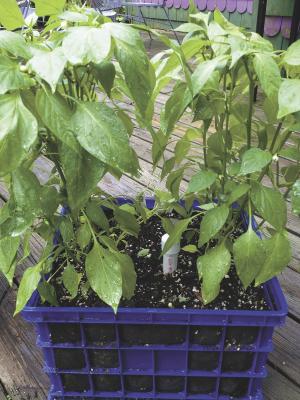Milk Crate Garden Has Internal Watering System
Who says you need tillable land to farm? Riverpark Farm in the heart of New York City grows food in a milk crate truck garden to serve local Riverpark restaurants. Thanks to a watering system developed by Barb Neal, a George Washington University professor, milk crate gardening can be done anywhere.
“The system is fully portable and works just fine on pavement and decks,” says Neal.
Her idea is to slip a bucket (cut down to about 6-in. tall with a lid on) inside a milk crate. She drills two 1-in. holes in the lid and cuts two pieces of 1-in. pvc pipe. One is slightly longer than the bucket height, and the other is nearly as tall as the milk crate. She drills a few 3/8-in. holes around the bottom of both pipes.
Then she cuts 4 strips into one half of a washcloth, leaving the other half intact. She wraps a rubber band around the top and slips that end into the top of the shorter tube, which is caulked in place. She spreads the cloth strips on top of the lid and pushes the long pipe through the other hole into the bucket. She fills the bucket with water through the pipe, and covers it with a pvc cap.
“You then add about 4 in. of soil above the bucket so the plants have plenty of soil to grow in,” Neal says. The buckets she uses hold enough water to last about a week.
Each milk crate is lined with geotextile fabric and weighs about 35 lbs. Pour in composted soil, then mix carefully to make sure the washcloth strips stay spread out in the soil, Neal says. The milk crate planter can be carried or moved with a dolly to inside shelter on cold nights to extend the growing season. By positioning the plant-filled crate on an empty milk crate, it is the perfect height for someone gardening from a wheelchair or to stand comfortably without having to bend over, Neal adds.
Used milk crates can often be found for free or crates can be purchased new for a few dollars. Because they are square and already have drainage, they are an inexpensive, practical way to create a modular garden anywhere, Neal says.
Contact: FARM SHOW Followup, Barb Neal, 216 Wood St., Ithaca, N.Y. 14850 (ph 607 319-0471; barb@greenlegacytrees.com; www.greenlegacytrees.com).

Click here to download page story appeared in.
Milk Crate Garden Has Internal Watering System FARM HOME Miscellaneous Who says you need tillable land to farm? Riverpark Farm in the heart of New York City grows food in a milk crate truck garden to serve local Riverpark restaurants Thanks to a watering system developed by Barb Neal a George Washington University professor milk crate gardening can be done anywhere “The system is fully portable and works just fine on pavement and decks ” says Neal Her idea is to slip a bucket cut down to about 6-in tall with a lid on inside a milk crate She drills two 1-in holes in the lid and cuts two pieces of 1-in pvc pipe One is slightly longer than the bucket height and the other is nearly as tall as the milk crate She drills a few 3/8-in holes around the bottom of both pipes Then she cuts 4 strips into one half of a washcloth leaving the other half intact She wraps a rubber band around the top and slips that end into the top of the shorter tube which is caulked in place She spreads the cloth strips on top of the lid and pushes the long pipe through the other hole into the bucket She fills the bucket with water through the pipe and covers it with a pvc cap “You then add about 4 in of soil above the bucket so the plants have plenty of soil to grow in ” Neal says The buckets she uses hold enough water to last about a week Each milk crate is lined with geotextile fabric and weighs about 35 lbs Pour in composted soil then mix carefully to make sure the washcloth strips stay spread out in the soil Neal says The milk crate planter can be carried or moved with a dolly to inside shelter on cold nights to extend the growing season By positioning the plant-filled crate on an empty milk crate it is the perfect height for someone gardening from a wheelchair or to stand comfortably without having to bend over Neal adds Used milk crates can often be found for free or crates can be purchased new for a few dollars Because they are square and already have drainage they are an inexpensive practical way to create a modular garden anywhere Neal says Contact: FARM SHOW Followup Barb Neal 216 Wood St Ithaca N Y 14850 ph 607 319-0471; barb@greenlegacytrees com; www greenlegacytrees com
To read the rest of this story, download this issue below or click
here to register with your account number.
